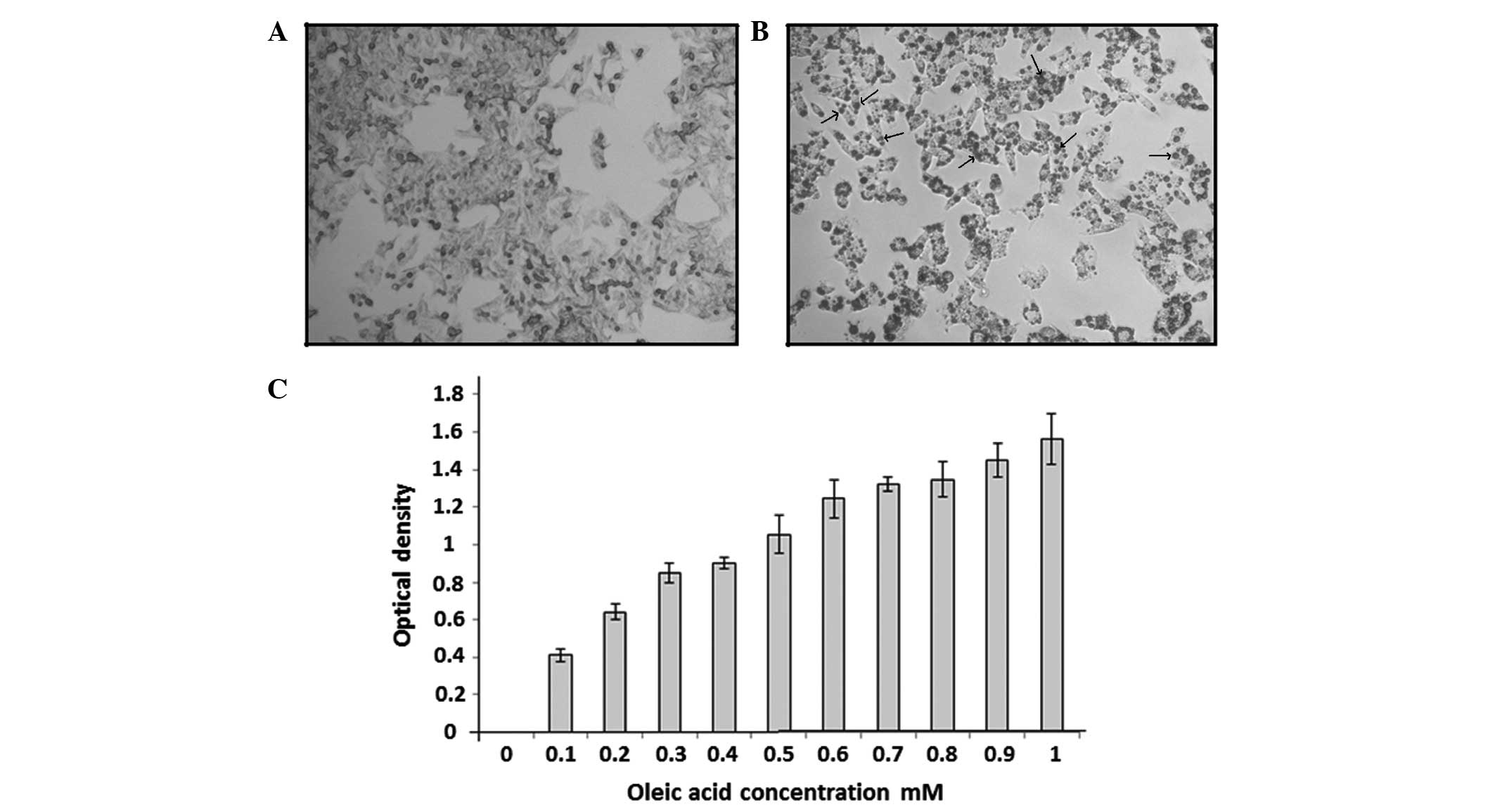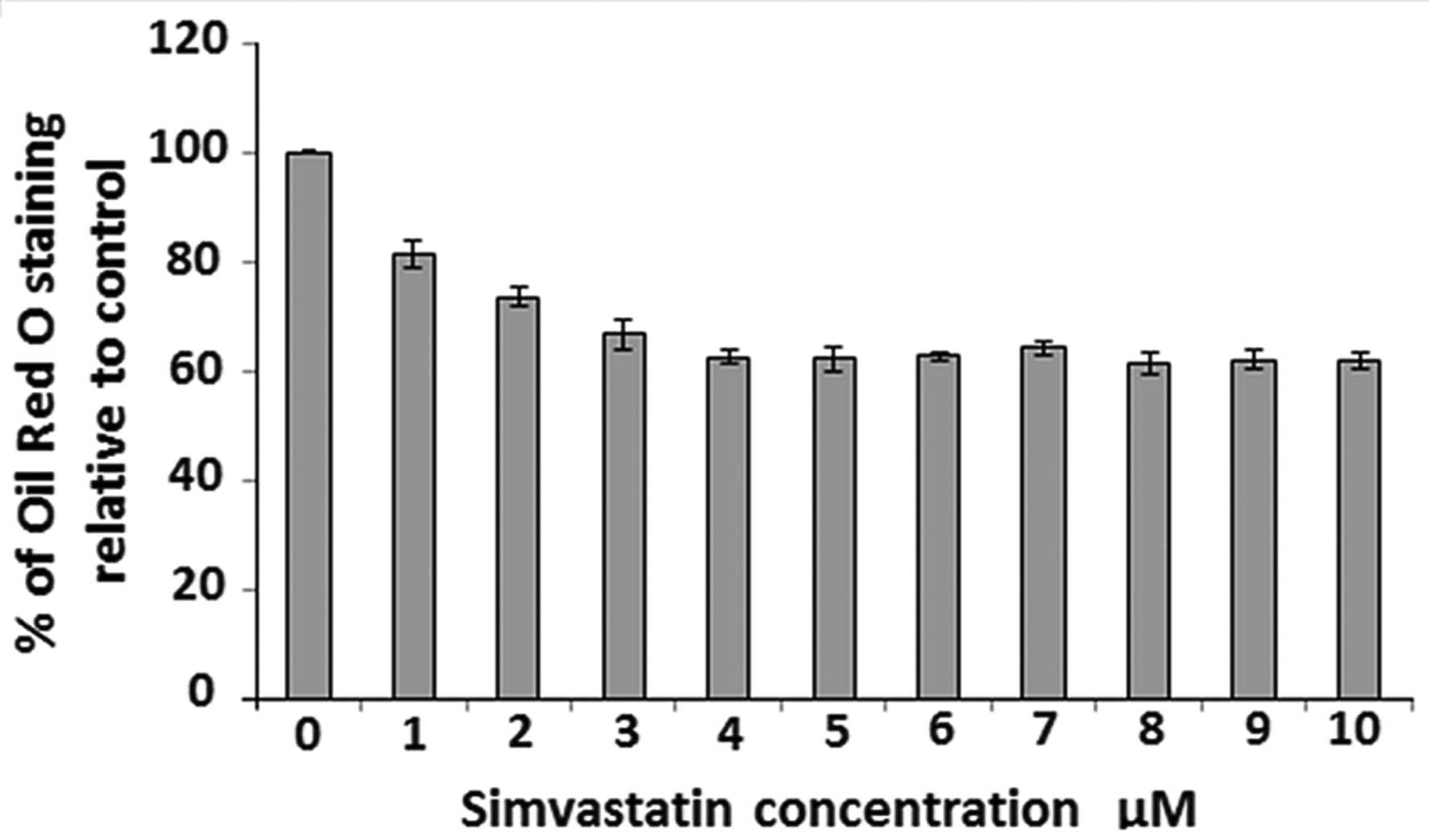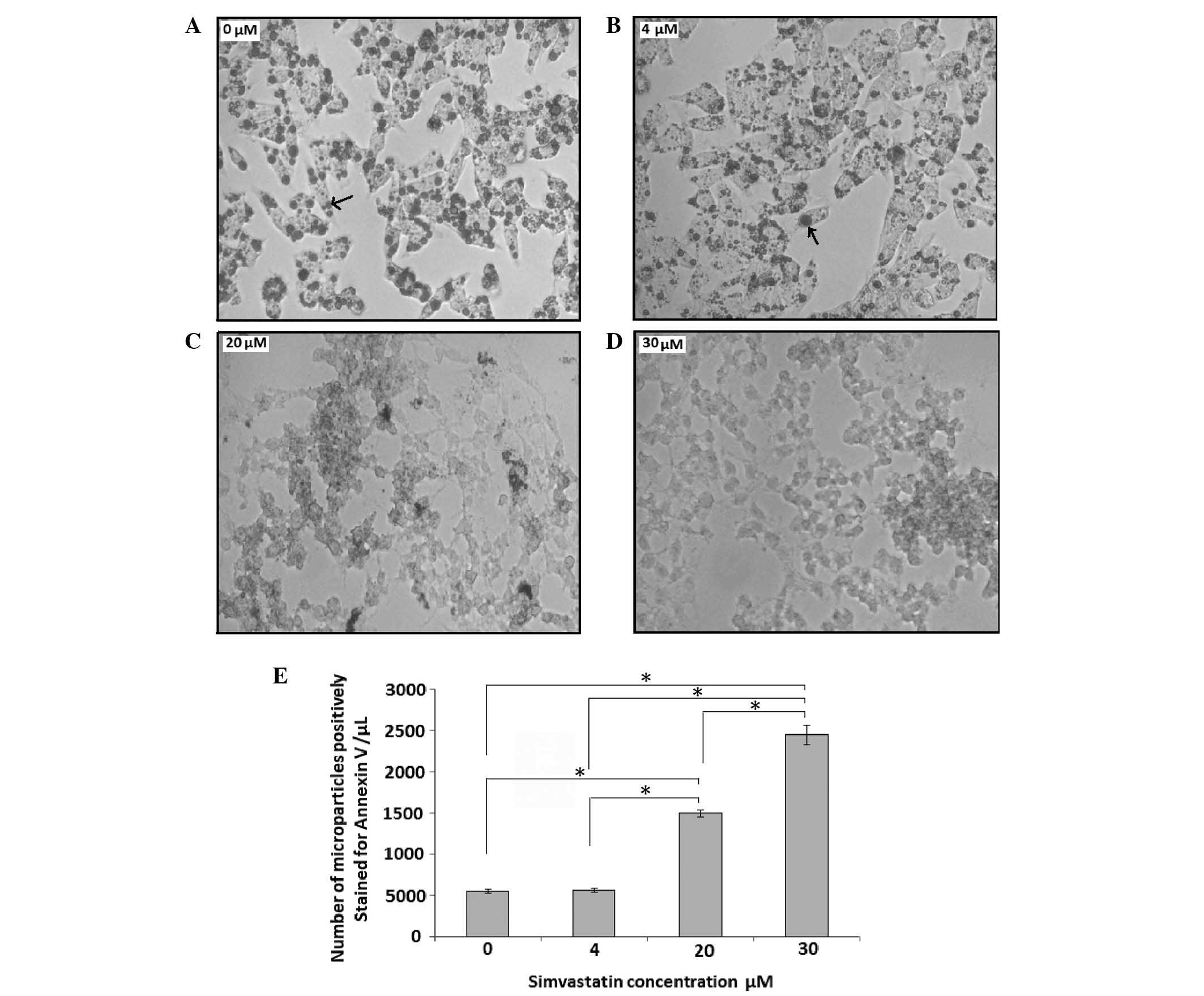|
1
|
Green CJ and Hodson L: The influence of
dietary fat on liver fat accumulation. Nutrients. 6:5018–5033.
2014. View Article : Google Scholar : PubMed/NCBI
|
|
2
|
Baraona E and Lieber CS: Effects of
ethanol on lipid metabolism. J Lipid Res. 20:289–315.
1979.PubMed/NCBI
|
|
3
|
Souza MR, Diniz Mde F, Medeiros-Filho JE
and Araújo MS: Metabolic syndrome and risk factors for
non-alcoholic fatty liver disease. Arq Gastroenterol. 49:89–96.
2012. View Article : Google Scholar : PubMed/NCBI
|
|
4
|
Marchesini G, Brizi M, Morselli-Labate AM,
Bianchi G, Bugianesi E, McCullough AJ, Forlani G and Melchionda N:
Association of nonalcoholic fatty liver disease with insulin
resistance. Am J Med. 107:450–455. 1999. View Article : Google Scholar : PubMed/NCBI
|
|
5
|
Pais R, Pascale A, Fedchuck L, Charlotte
F, Poynard T and Ratziu V: Progression from isolated steatosis to
steatohepatitis and fibrosis in nonalcoholic fatty liver disease.
Clin Res Hepatol Gastroenterol. 35:23–28. 2011. View Article : Google Scholar : PubMed/NCBI
|
|
6
|
Onnerhag K, Nilsson PM and Lindgren S:
Increased risk of cirrhosis and hepatocellular cancer during
long-term follow-up of patients with biopsy-proven NAFLD. Scand J
Gastroenterol. 49:1111–1118. 2014. View Article : Google Scholar : PubMed/NCBI
|
|
7
|
Centis E, Marzocchi R, Suppini A, Dalle
Grave R, Villanova N, Hickman IJ and Marchesini G: The role of
lifestyle change in the prevention and treatment of NAFLD. Curr
Pharm Des. 19:5270–5279. 2013. View Article : Google Scholar : PubMed/NCBI
|
|
8
|
Angelico F, Burattin M, Alessandri C, Del
Ben M and Lirussi F: Drugs improving insulin resistance for
non-alcoholic fatty liver disease and/or non-alcoholic
steatohepatitis. Cochrane Database Syst Rev.
CD0051662007.PubMed/NCBI
|
|
9
|
Tolman KG and Dalpiaz AS: Treatment of
non-alcoholic fatty liver disease. Ther Clin Risk Manag.
3:1153–1163. 2007.PubMed/NCBI
|
|
10
|
Basaranoglu M, Acbay O and Sonsuz A: A
controlled trial of gemfibrozil in the treatment of patients with
nonalcoholic steatohepatitis. J Hepatol. 31:3841999. View Article : Google Scholar : PubMed/NCBI
|
|
11
|
Hyogo H, Tazuma S, Arihiro K, Iwamoto K,
Nabeshima Y, Inoue M, Ishitobi T, Nonaka M and Chayama K: Efficacy
of atorvastatin for the treatment of nonalcoholic steatohepatitis
with dyslipidemia. Metabolism. 57:1711–1728. 2008. View Article : Google Scholar : PubMed/NCBI
|
|
12
|
Kiyici M, Gulten M, Gurel S, Nak SG, Dolar
E, Savci G, Adim SB, Yerci O and Memik F: Ursodeoxycholic acid and
atorvastatin in the treatment of nonalcoholic steatohepatitis. Can
J Gastroenterol. 17:713–718. 2003. View Article : Google Scholar : PubMed/NCBI
|
|
13
|
Calderon RM, Cubeddu LX, Goldberg RB and
Schiff ER: Statins in the treatment of dyslipidemia in the presence
of elevated liver aminotransferase levels: A therapeutic dilemma.
Mayo Clin Proc. 85:349–356. 2010. View Article : Google Scholar : PubMed/NCBI
|
|
14
|
Eslami L, Merat S, Malekzadeh R,
Nasseri-Moghaddam S and Aramin H: Statins for non-alcoholic fatty
liver disease and non-alcoholic steatohepatitis. Cochrane Database
Syst Rev. 12:CD0086232013.PubMed/NCBI
|
|
15
|
Egan M and Prasad S: PURLs: Statins for
patients with nonalcoholic fatty liver? J Fam Pract. 60:536–538.
2011.PubMed/NCBI
|
|
16
|
Nseir W and Mahamid M: Statins in
nonalcoholic fatty liver disease and steatohepatitis: Updated
review. Curr Atheroscler Rep. 15:3052013. View Article : Google Scholar : PubMed/NCBI
|
|
17
|
Dima A, Marinescu AG and Dima AC:
Non-alcoholic fatty liver disease and the statins treatment. Rom J
Intern Med. 50:19–25. 2012.PubMed/NCBI
|
|
18
|
Cui W, Chen SL and Hu KQ: Quantification
and mechanisms of oleic acid-induced steatosis in HepG2 cells. Am J
Transl Res. 2:95–104. 2010.PubMed/NCBI
|
|
19
|
Liu JF, Ma Y, Wang Y, Du ZY, Shen JK and
Peng HL: Reduction of lipid accumulation in HepG2 cells by luteolin
is associated with activation of AMPK and mitigation of oxidative
stress. Phytother Res. 25:588–596. 2011. View Article : Google Scholar : PubMed/NCBI
|
|
20
|
Susztak K, Ciccone E, McCue P, Sharma K
and Böttinger EP: Multiple metabolic hits converge on CD36 as novel
mediator of tubular epithelial apoptosis in diabetic nephropathy.
PLoS Med. 2:e452005. View Article : Google Scholar : PubMed/NCBI
|
|
21
|
Rossi J, Rouleau L, Tardif JC and Leask
RL: Effect of simvastatin on Kruppel-like factor2, endothelial
nitric oxide synthase and thrombomodulin expression in endothelial
cells under shear stress. Life Sci. 87:92–99. 2010. View Article : Google Scholar : PubMed/NCBI
|
|
22
|
Alkhatatbeh MJ, Enjeti AK, Acharya S,
Thorne RF and Lincz LF: The origin of circulating CD36 in type 2
diabetes. Nutr Diabetes. 3:e592013. View Article : Google Scholar : PubMed/NCBI
|
|
23
|
Robert S, Poncelet P, Lacroix R, Arnaud L,
Giraudo L, Hauchard A, Sampol J and Dignat-George F:
Standardization of platelet-derived microparticle counting using
calibrated beads and a Cytomics FC500 routine flow cytometer: A
first step towards multicenter studies? J Thromb Haemost.
7:190–197. 2009. View Article : Google Scholar : PubMed/NCBI
|
|
24
|
Lacroix R, Robert S, Poncelet P, Kasthuri
RS, Key NS and Dignat-George F: ISTH SSC Workshop: Standardization
of platelet-derived microparticle enumeration by flow cytometry
with calibrated beads: Results of the International Society on
Thrombosis and Haemostasis SSC collaborative workshop. J Thromb
Haemost. 8:2571–2574. 2010. View Article : Google Scholar : PubMed/NCBI
|
|
25
|
Hargett LA and Bauer NN: On the origin of
microparticles: From platelet dust to mediators of intercellular
communication. Pulm Circ. 3:329–340. 2013. View Article : Google Scholar : PubMed/NCBI
|
|
26
|
Gomez-Lechón MJ, Donato MT,
Martínez-Romero A, Jiménez N, Castell JV and O'Connor JE: A human
hepatocellular in vitro model to investigate steatosis. Chem Biol
Interact. 165:106–116. 2007. View Article : Google Scholar : PubMed/NCBI
|
|
27
|
de Keyser CE, Koehler EM, Schouten JN,
Visser LE, Hofman A, Janssen HL and Stricker BH: Statin therapy is
associated with a reduced risk of non-alcoholic fatty liver in
overweight individuals. Dig Liver Dis. 46:720–725. 2014. View Article : Google Scholar : PubMed/NCBI
|
|
28
|
Endo A: The discovery and development of
HMG-CoA reductase inhibitors. J Lipid Res. 33:1569–1582.
1992.PubMed/NCBI
|
|
29
|
Liao JK and Laufs U: Pleiotropic effects
of statins. Annu Rev Pharmacol Toxicol. 45:89–118. 2005. View Article : Google Scholar : PubMed/NCBI
|
|
30
|
Stein EA, Lane M and Laskarzewski P:
Comparison of statins in hypertriglyceridemia. Am J Cardiol.
81:66B–69B. 1998. View Article : Google Scholar : PubMed/NCBI
|
|
31
|
Huang X, Ma J, Xu J, Su Q and Zhao J:
Simvastatin induces growth inhibition and apoptosis in HepG2 and
Huh7 hepatocellular carcinoma cells via upregulation of Notch1
expression. Mol Med Rep. 11:2334–2340. 2015.PubMed/NCBI
|
|
32
|
Kah J, Wüstenberg A, Keller AD, Sirma H,
Montalbano R, Ocker M, Volz T, Dandri M, Tiegs G and Sass G:
Selective induction of apoptosis by HMG-CoA reductase inhibitors in
hepatoma cells and dependence on p53 expression. Oncol Rep.
28:1077–1083. 2012.PubMed/NCBI
|
|
33
|
Relja B, Meder F, Wilhelm K, Henrich D,
Marzi I and Lehnert M: Simvastatin inhibits cell growth and induces
apoptosis and G0/G1 cell cycle arrest in hepatic cancer cells. Int
J Mol Med. 26:735–741. 2010. View Article : Google Scholar : PubMed/NCBI
|












